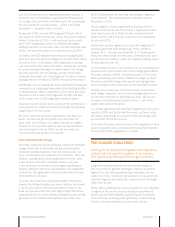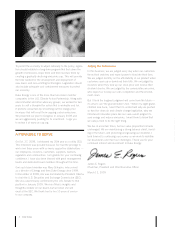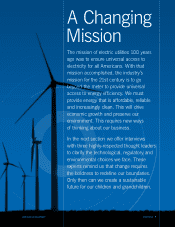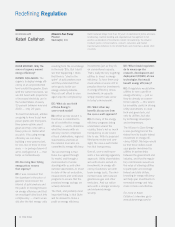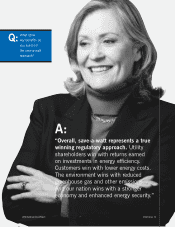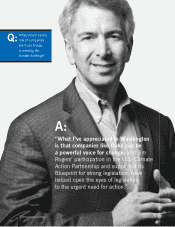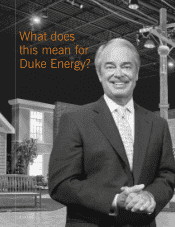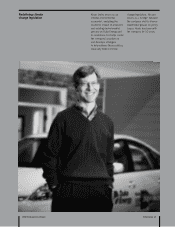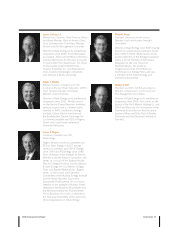Duke Energy 2008 Annual Report Download - page 19
Download and view the complete annual report
Please find page 19 of the 2008 Duke Energy annual report below. You can navigate through the pages in the report by either clicking on the pages listed below, or by using the keyword search tool below to find specific information within the annual report.
2008 Summary Annual Report Duke Energy 17
The interviews on the
preceding pages illustrate
the importance of diverse
perspectives in exploring
ways to redefine our bound-
aries and successfully
transition to a low-carbon
future. I’d like to discuss what
the insights of these leaders
mean for Duke Energy. Let’s
consider them in the context
of the two key aspirations
I described in last year’s
summary annual report:
1. Modernize and
decarbonize our
generation fleet, and
2. Help make the communi-
ties we serve the most
energy efficient in the
world.
Twenty years from now,
when our children and their
children look back at energy
efficiency, they will probably
marvel at some of the ways
we tried to save energy,
including using compact
fluorescent light bulbs,
caulking windows and
installing insulation. Today,
the policies we propose
and new technologies we
develop to further energy
efficiency are designed to
achieve one goal: to ease the
transition to a new energy-
efficient society in which
future generations can thrive
and raise their families.
As Larry Makovich noted
(on page 10), technology
is key to achieving greater
energy efficiency in the
future. But we must not
lose sight of our near-term
mission: to help our
customers better monitor
and manage their energy
use in their homes and
businesses. To do this,
we will partner with our
customers by installing
sensors, switches and other
devices on their appliances
and equipment, and also
help to write the software
to operate this equipment.
But as we develop new tech-
nologies, it is essential that
we remain flexible. Unlike
other current smart grid
programs, our plan doesn’t
focus exclusively on the
meter. Sure, advanced
metering is essential to
greater energy savings, but
we view the smart meter
as only one of the many
“endpoints” for providing
more energy information
for customers. We’re also
working with our partners to
keep technology standards
open to allow plug-and-play
compatibility with equipment
across multiple systems.
Recently, the Gridwise
Alliance, a consortium
of public and private
stakeholders, acknowledged
Duke Energy in a report.
The group, which is
dedicated to modernizing
our nation’s electric grid,
applauded our comprehen-
sive efforts to fully integrate
advanced metering and
smart grid technologies.
As Kateri Callahan observed
(on page 12), we also need
a new regulatory model to
realize our children’s and
grandchildren’s legacy. This
system must give us the right
energy efficiency incentives
for customers and provide
a fair return on capital
investments for investors.
That’s the goal of our save-
a-watt model. It will provide
incentives to create energy
efficiency similar to incen-
tives we have to build new
power plants to meet
growing customer demand
for electricity. Using this
approach, we would earn
revenue based on a
discounted amount of what
it would cost us to build
an equivalent amount of
new generation.
Our customers save money,
our investors earn a return
and there is no environ-
mental impact because, with
the increase in energy effi-
ciency, we don’t need to
build a new power plant.
Finally, as Fred Krupp
commented (on page 14),
we stand a good chance
of seeing federal climate
change legislation pass in
2009. It is vital that such
legislation treats all sectors
of the economy fairly. To
effectively stem carbon
emissions without further
weakening our economy,
legislation must provide for
significant investments in the
research, development and
deployment of new lower-
emitting technologies.
While that is going on, we
must be able to expand our
use of cleaner coal, nuclear,
natural gas, renewables and
energy efficiency to meet the
increasing demand for elec-
tricity. Keeping everything
in the mix gives us the time
we need to decarbonize and
modernize our generation
fleet for a carbon-constrained
world, and without huge
price hikes for our customers.
Next up is a glimpse of how
we are redefining our busi-
ness model to address these
21st century challenges.
You’ll also meet several
of our employees who are
working to achieve our two
key aspirations above.
Redefining Our Boundaries
Jim Rogers Chairman, President and
Chief Executive Officer
Duke Energy
Charlotte, N.C.
Jim Rogers stands in the Envision Center by Duke Energy. Located near
Cincinnati, Ohio, the center showcases the vision for and educates stake-
holder groups about the company’s future utility efforts, including the
smart grid and the save-a-watt energy efficiency program. Since opening
last fall, the center has hosted diverse public and private groups, including
manufacturers of plug-in hybrid electric vehicles, who have used the
center’s “smart garage” to demonstrate their prototypes.


